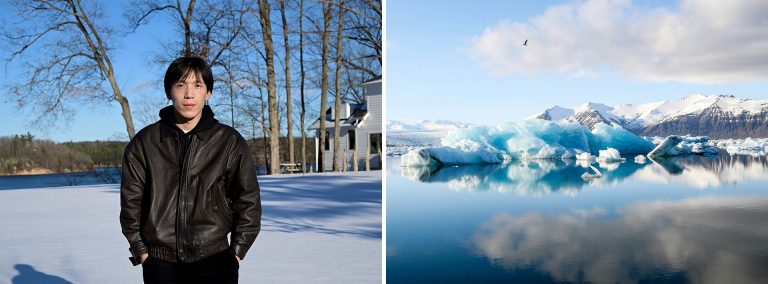Concordia PhD student wins a Prix Relève étoile for his study on microplastic pollution in cold climates

Plastic waste, particularly in the form of tiny particles called microplastic, has become ubiquitous in the Earth’s environment, including the remote Arctic. Yet, the factors influencing how these tiny particles are trapped in ice remain poorly understood.
Now, award-winning research from Concordia PhD candidate Zhikun Chen has shed some light on the matter. He is studying under the co-supervision of professors Chunjiang An and Maria Elektorowicz in the Department of Building, Civil and Environmental Engineering at the Gina Cody School of Engineering and Computer Science.
Chen’s research explores how plastic properties and environmental factors, such as water salinity and turbulence, affect the transport and behaviour of microplastics in cold regions. His recent paper, “Entrainment and Enrichment of Microplastics in Ice Formation Processes: Implications for the Transport of Microplastics in Cold Regions,” has been honoured with February’s Prix Relève étoile Louis-Berlinguet from the Fonds de recherche du Québec – Nature et technologies (FRQNT).
The monthly prize promotes and recognizes exceptional research by graduate students and postdoctoral fellows in the province.
How sea ice ‘traps’ microplastics
Microplastics are tiny plastic particles smaller than five millimetres long. As such, they are often invisible to the naked eye.
Microplastics can take many forms and come from many different sources, but a key contributor is discarded plastic waste. Since plastic biodegrades very slowly, these fragments eventually find themselves in waterways and oceans, where they can be carried by currents or become integrated into glaciers.
Chen’s research shows that, when sea ice forms, it can "trap" these microplastics. But when ice melts, these trapped plastics are released into the water.
While past studies have looked at the concentration of microplastics in Arctic sea ice, none have looked at how microplastics behave in this type of environment. Chen was able to study their behaviour in cold and icy conditions in a lab setting where he could control the environment.
He used an environmental chamber that can imitate cold environments to simulate the formation of ice in freshwater or oceans, with controlled water currents. The setup allows the top layer of water to freeze, leaving the water beneath liquid, thereby simulating real sea environments in cold conditions.
Chen then determined the extent of microplastic entrapment in the ice by measuring changes in the concentration of suspended microplastic particles in the water.
The researcher found that rougher, more turbulent waters enhance the entrapment of microplastics in ice. He also found that hydrophobic microplastics (plastics that repel water) are more easily trapped in ice.
As part of his PhD, Chen is also investigating how the process of freezing and thawing affects microplastic properties.
“I hope this research can help us develop environmental policies around microplastic pollution in cold regions,” Chen says. “We have been using plastic for decades and there's lots of plastic stored in multiple layers of ice. In the context of climate change, more and more sea ice is melting, which means stored microplastics can be released again into the environment. So, it’s very important for us to understand how this process affects microplastic properties.”
Read the cited paper: “Entrainment and Enrichment of Microplastics in Ice Formation Processes: Implications for the Transport of Microplastics in Cold Regions.”
Find out more about Concordia’s School of Graduate Studies.


